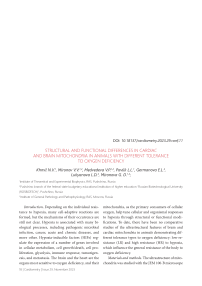Structural and functional differences in cardiac and brain mitochondria in animals with different tolerance to oxygen deficiency
Автор: Khmil N.V., Mironov V.V., Medvedeva V.P., Pavlik L.L., Germanova E.L., Lukyanova L.D., Mironova G. D.
Журнал: Cardiometry @cardiometry
Рубрика: Conference proceedings
Статья в выпуске: 29, 2023 года.
Бесплатный доступ
Depending on the individual resistance to hypoxia, many cell-adaptive reactions are formed, but the mechanisms of their occurrence are still not clear. Hypoxia is associated with many biological processes, including pathogenic microbial infection, cancer, acute and chronic diseases, and more other. Hypoxia-inducible factors (HIFs) regulate the expression of a number of genes involved in cellular metabolism, cell growth/death, cell proliferation, glycolysis, immune response, tumorigenesis, and metastasis. The brain and the heart are the organs most sensitive to oxygen deficiency, and their mitochondria, as the primary consumers of cellular oxygen, help tune cellular and organismal responses to hypoxia through structural or functional modifications. To date, there have been no comparative studies of the ultrastructural features of brain and cardiac mitochondria in animals demonstrating different tolerance types to oxygen deficiency: low-resistance (LR) and high resistance (HR) to hypoxia, which influence the general resistance of the body to oxygen deficiency.
Hypoxia, interfibrillar, subsarcolemmal, perinuclear mitochondria, ultrastructure
Короткий адрес: https://sciup.org/148327383
IDR: 148327383 | DOI: 10.18137/cardiometry.2023.29.conf.11
Текст статьи Structural and functional differences in cardiac and brain mitochondria in animals with different tolerance to oxygen deficiency
1Institute of Theoretical and Experimental Biophysics, RAS, Pushchino, Russia
2Pushchino branch of the federal state budgetary educational institution of higher education “Russian Biotechnological University (ROSBIOTECH)”, Pushchino, Russia
3Institute of General Pathology and Pathophysiology, RAS, Moscow, Russia
Introduction . Depending on the individual resistance to hypoxia, many cell-adaptive reactions are formed, but the mechanisms of their occurrence are still not clear. Hypoxia is associated with many biological processes, including pathogenic microbial infection, cancer, acute and chronic diseases, and more other. Hypoxia-inducible factors (HIFs) regulate the expression of a number of genes involved in cellular metabolism, cell growth/death, cell proliferation, glycolysis, immune response, tumorigen-esis, and metastasis. The brain and the heart are the organs most sensitive to oxygen deficiency, and their 18 | Cardiometry | Issue 29. November 2023
mitochondria, as the primary consumers of cellular oxygen, help tune cellular and organismal responses to hypoxia through structural or functional modifications. To date, there have been no comparative studies of the ultrastructural features of brain and cardiac mitochondria in animals demonstrating different tolerance types to oxygen deficiency: low-resistance (LR) and high resistance (HR) to hypoxia, which influence the general resistance of the body to oxygen deficiency.
Materials and methods . The ultrastructure of mitochondria was studied with the JEM 100-B microscope
(Japan); subsequent data processing was carried out using the Image J software.
Results . Based on their localization in the cell, cardiomyocyte mitochondria are usually divided into three mitochondria subpopulations as follows: inter-fibrillar (IF), subsarcolemmal (SS) and perinuclear (PN) mitochondria. Our research work has established that the LR and HR animals have initial differences in the structure of all three types of cardiac mitochondria, which possibly shape the nature of the resistance of these animals to hypoxia:
-
1. Normally, the IF mitochondria of both studied phenotypes in the animals had a shape characteristic of that subpopulation and were located clearly along the rows of myofibrils, however, the IF mitochondria of the LR group had a lighter matrix than mitochondria of the HR group. In addition, while the IF mitochondria in the LR animals, as a rule, are located in one row between the myofibrils, in the HR animals they are often localized in 2 or more rows.
-
2. The SS mitochondria in the LR animals were characterized by the location of one organelle each in the invaginations of the sarcolemmel membrane, which gave the membrane a convoluted shape, while the same mitochondria in the HR group were located in small clusters under the sarcolemmel membrane.
-
3. The average density of the PN organelles, as well as the average number of small mitochondria, was found to be significantly higher in the HR animals.
Our investigation of the ultrastructure of the prefrontal cortex (PFC) showed that mitochondria both in the LR and HR rats have a round or an elongated shape with a diameter of 0.6-1 μm, without abnormalities in the location of the cristae and without significant damages to the external and internal membranes. At the same time, the ultrastructure of mitochondria in the PFC of the two studied types of animals differs significantly. The morphometric analysis shows that:
Conclusions . Thus, the data obtained indicate the existence of the basic ultrastructural differences between mitochondria in the heart and the PFC of two animal phenotypes. A reduced matrix density, less dense packing of cristae and a smaller total number and the number of small-sized mitochondria in the PFC and in the IF and PN type of the cardiac mitochondria, as well as the nature of the location of mitochondria in the sub-sarcolemmal zone in the LR animals, compared to the HR animals, apparently determine the decreased resistance to hypoxia in the LR rats.


